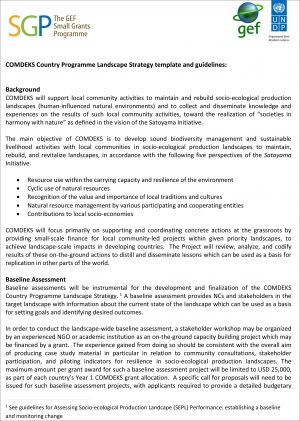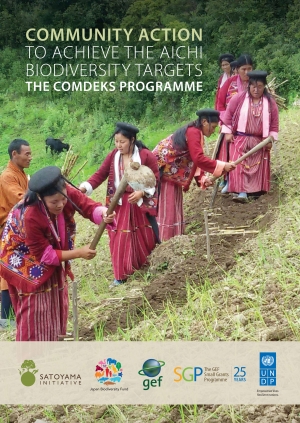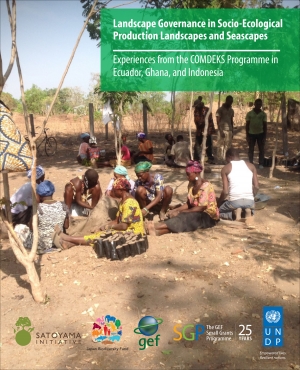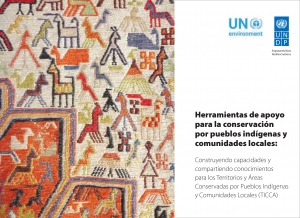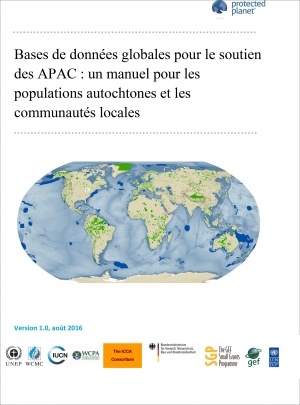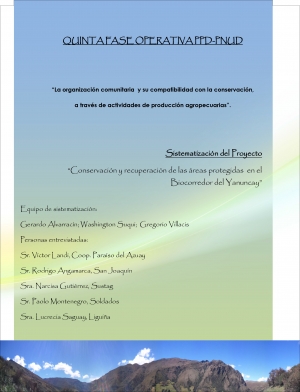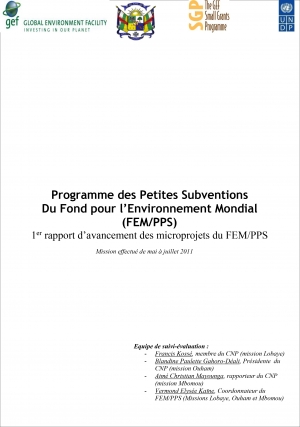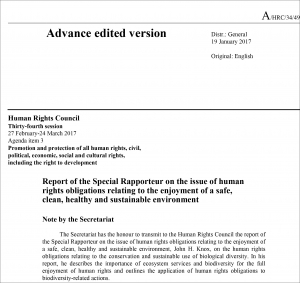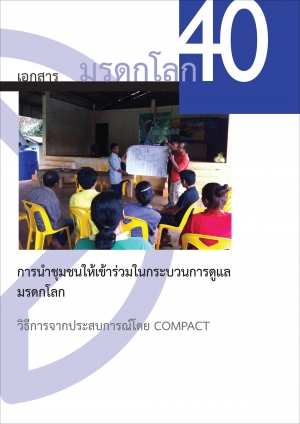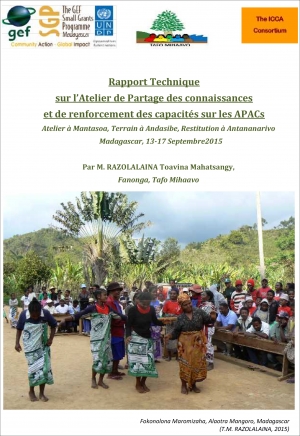This booklet highlights COMDEKS contributions to achieving the Aichi Biodiversity Targets, as well as the critical role that local communities play in ecosystem protection and biodiversity conservation.
The publication contains two parts:
Part 1 introduces COMDEKS and its community-based landscape approach for conserving ecosystems and biodiversity and promoting sustainable livelihoods. It outlines the rationale for why community action is vital to conserving biodiversity in rural landscapes outside of Protected Areas.
Part 2 portrays how COMDEKS has contributed to achieving all five of the Strategic Goals of the Strategic Plan for Biodiversity 2011-2020 and many of the individual Aichi Biodiversity Targets, showcasing a variety of best practices and results from supported projects.
This publication presents experiences from successful on-the-ground actions to maintain and rebuild socio-ecological production landscapes with particular respect to landscape governance, drawing on COMDEKS-supported projects in Ecuador, Ghana and Indonesia.This publication has three principal parts:(1) The introduction briefly outlines the importance of governance in socio-ecological production landscapes and seascapes;(2) Three case studies describe the socio-ecological landscape and its governance structure at the onset of each project, the COMDEKS landscape strategy and activities, developments in governance during the project, and finally lessons learned and challenges ahead; and(3) The conclusions attempt to sum up the lessons learned and successful approaches from these COMDEKS experiences with respect to landscape governance.
The ICCA toolkit was intitally published in English in 2013. It is now available in Spanish and French.
The toolkit documents sixteen case studies and highlights innovative tools and approaches developed to help local communities address critical challenges that affect their natural and cultural resources. It includes a diverse set of resources organized around five key themes (documentation, management planning, monitoring and evaluation, communication, and finance and values). The publication also offers a suite of tools to support the effectiveness and viability of ICCAs as governance structures for the protection of biodiversity and ecosystems.
In addition to being a valuable resource to practitioners, the toolkit provides a reminder to policy-makers that the achievement of the emerging post-2015 sustainable development goals (SDGs) will need to be linked to a comprehensive valuation of ecosystem services, as well as to be spearheaded at the grassroots by local civil society initiatives.
Ce manuel a été écrit pour les populations autochtones ou les communautés locales qui ont déterminé que leur territoire ou aire répond aux critères qui définissent une APAC (voir les termes clés), autrement considéré comme un territoire ou une aire dont la gouvernance, gestion et conservation est assurée par une population autochtone ou une communauté locale. Il est aussi conçu pour ceux qui travaillent en étroite collaboration avec les conservateurs d’APAC, tel que les ONG locales qui peuvent souhaiter soumettre des informations concernant une ou plusieurs APAC. Il n’est pas destiné à être utilisé par des gouvernements. Les gouvernements qui souhaitent fournir des informations concernant leurs systèmes d’aires protégées sont orientés vers le manuel d’utilisation de la WDPA.
The UN Special Rapporteur, Mr. John Knox, presented a report to the UN Human Rights Council (UNHRC) on the issue of human rights obligations relating to the enjoyment of a safe, clean, healthy and sustainable environment and its correlationn to the human rights obligations relating to the conservation and sustainable use of biological diversity. In his report, he describes the importance of ecosystem services and biodiversity for the full enjoyment of human rights and outlines the application of human rights obligations to biodiversity-related actions.
COMPACT: Engaging Local Communities in Stewardship of World Heritage, first published in 2013, has been translated to Thai as SGP and its ICCA-GSI partners strengthen the technical knowledge and skills of staff Thailand's National Parks, Wildlife and Plant Conservation. The objective of the capacity builiding support is to enhance the the effectiveness of World Heritage sites and protected areas (PA) by engaging indigenous peoples and local communties in the management and governance systems.
The publication covers the following topics:
(i.) Designing a working model to engage local communities in the stewardship of World Heritage Sites; (ii.) Key planning frameworks for COMPACT’s landscape and seascape approach; (iii.) COMPACT in the Sian Ka’an landscape: Working with indigenous peoples and local communities in key thematic areas; (iv.) Incorporating new methodologies and techniques into COMPACT’s work at landscape level: The Mt. Kenya World Heritage Site; (v.) Building capacity: Helping grantees develop and manage their projects in a demand-driven programme; (vi.) Bringing communities into the management of protected areas: Experience from COMPACT Mt. Kilimanjaro; (vii.) COMPACT Madagascar: Conservation at the landscape scale across a mosaic of different governance regimes; (viii.) Working with indigenous peoples in the conservation and management of Puerto Princesa Subterranean River National Park, Philippines; (ix.) Community engagement in the Djoudj National Bird Sanctuary and World Heritage site within the governance of a Transboundary Biosphere Reserve; (x.) Building the capacity of local small and medium-sized enterprises through business development services; and (xi.) Looking ahead: potential new opportunities for COMPACT to support the World Heritage Convention
13-17 September 2015, Analamanga region, Madagascar - ICCA-GSI partners, SGP and the ICCA Consortium, co-organized this workshop with the National Bureau of Tafo Mihaavo and FANONGA to bring multi-level stakeholders together to strengthen the recognition and support to Indigenous peoples and community-conserved territories and areas (ICCAs) in Madagascar.
Madagascar is a cradle of cultures and one of the mega-biodiversity countries of the planet. It includes an abundance of territories and areas that are usually governed, managed and conserved by the local communities. These ICCAs are called Fokonolona in Madagascar. Since the beginning of the new millennium, ICCAs have been identified by various social and cultural actors who have understood that they can help them advance on many important objectives. However, further support in the appropriate recognition for ICCAs is necessary to ensure that communities have collective rights and responsibilities on their lands as well as to promote respect for their traditional knowledge, practices and institutions. Appropriate ICCA recognition and working with local and national authorities on promoting of ICCA sustainable lifestyles, cultural identity and pride in communities help prevent rural exodus and strengthen social peace and security. Similarly, partnerships with civil society organizations will enable the integration of ICCAs’ long-term viability of nature conservation practices that rely more on internal integrity and capacity, rather than on external technical and financial support flows.
The workshop was attended by more than 73 people who gathered in Mantasoa and Andasibe, located in the east of Antananarivo in the Analamanga region. The participatory workshop included presentations, songs and working groups on schematic discussions capturing various landscapes and seascapes with mixed natural and cultural riches or bio-cultures, with a heavy focus on tradition and practices accepted by the Fokonolona.




